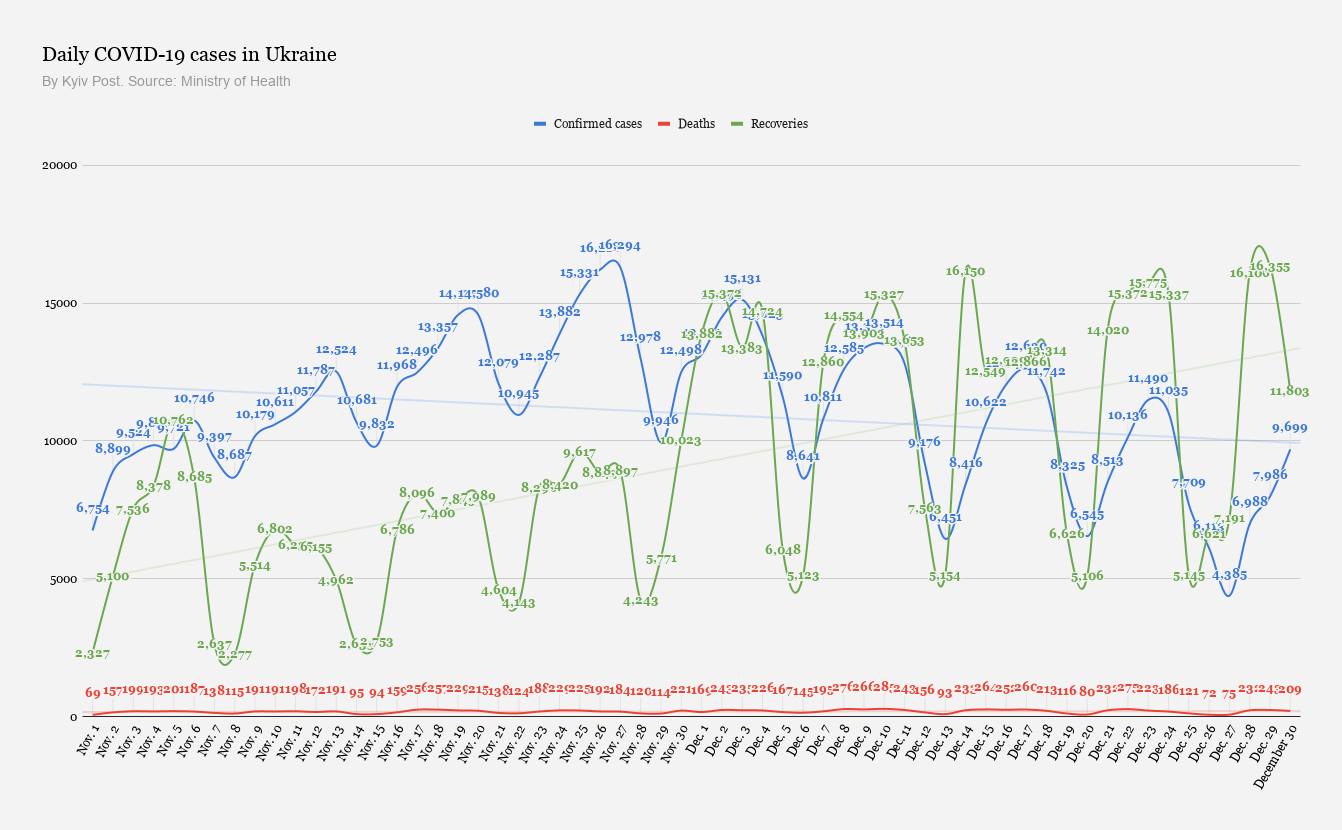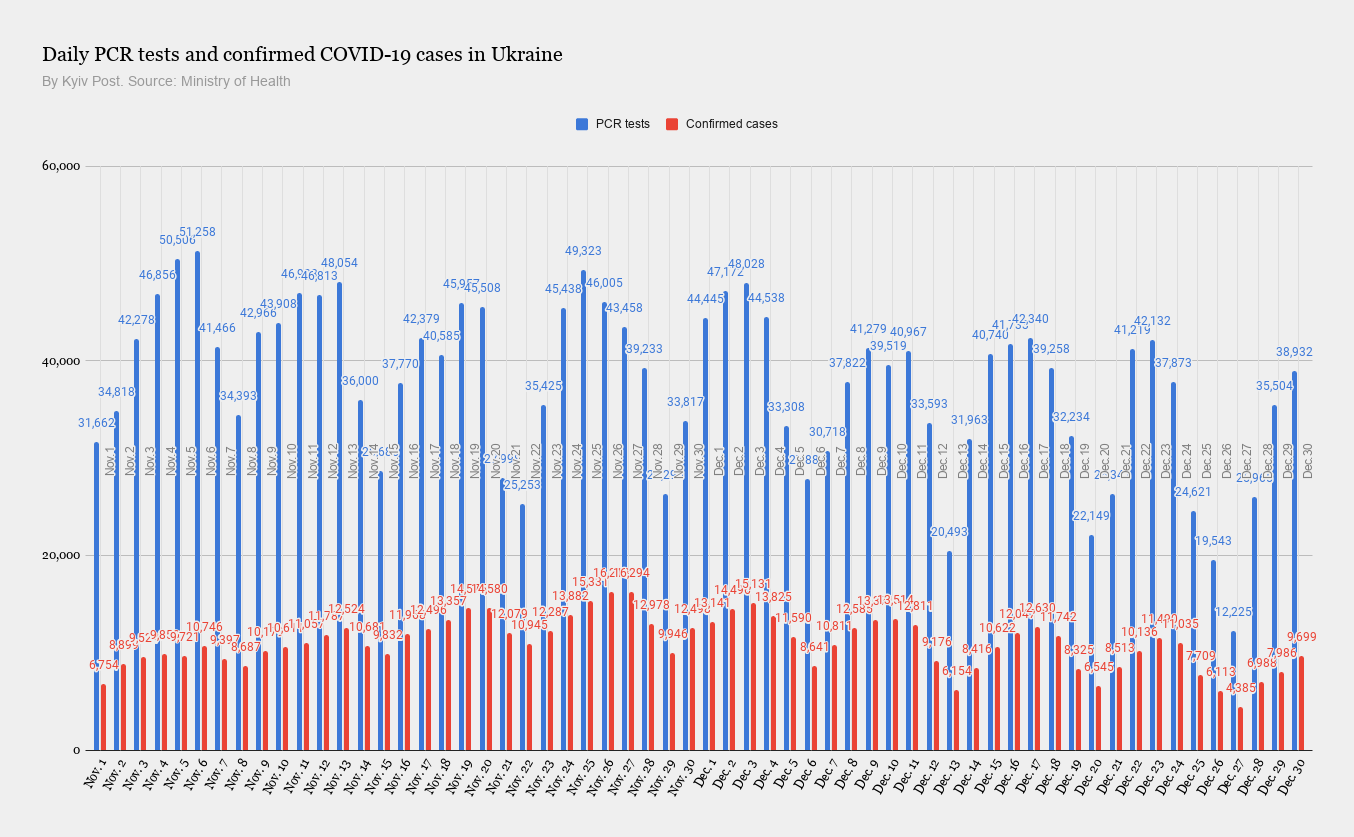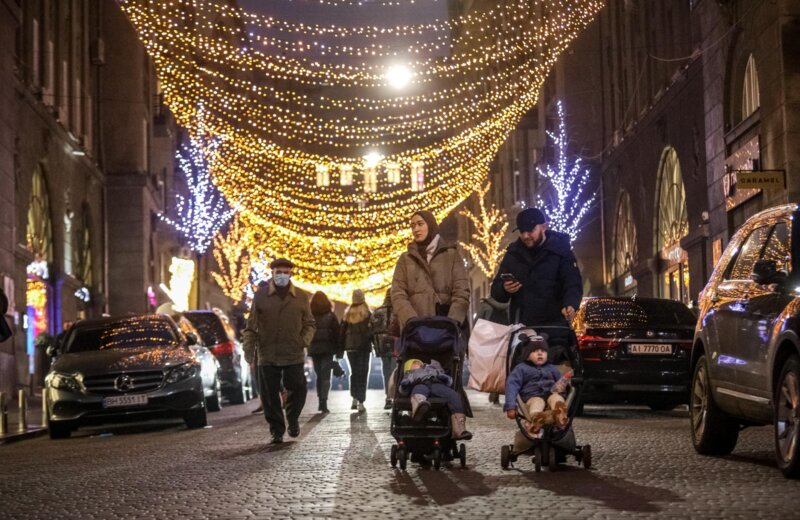Ukraine has registered 9,699 new cases of COVID-19 as of 9 a.m. on Dec. 31, bringing the total number of cases in the country since the start of the pandemic to 1,055,047.
Currently, there are 328,834 active cases across the country. In the past 24 hours, 2,704 people were hospitalized, while 11,803 have recovered.
Ukraine has registered 209 deaths in the past 24 hours. A total of 709,993 patients have recovered and 18,533 have died in Ukraine since the beginning of the pandemic.
The largest numbers of new cases have been recorded in the city of Kyiv (1,332), Kyiv Oblast (669), Kharkiv Oblast (570), and Odesa Oblast (533).

Ukraine’s daily COVID-19 cases, deaths and recoveries from Nov. 1 to Dec. 30, 2020. All data were released by the Ministry of Health.
In the past 24 hours, Ukrainian laboratories have carried out 38,932 polymerase chain reaction (PCR) tests and 19,615 antibody tests. Over 5.6 million PCR tests have been conducted since the start of the pandemic.

Ukraine’s daily new COVID-19 cases and polymerase chain reaction (PCR) tests, the most accurate way of diagnosing the novel coronavirus, between Nov. 1 and Dec. 30, 2020.
On Dec. 30, the President’s Office stated that Ukraine’s Ministry of Health had signed a contract for the country to receive 1.9 million doses of the coronavirus vaccine produced by China’s Sinovac Biotech “in the shortest possible term.” Each dose will be purchased for Hr 504 (just under $18).
On Dec. 26, Deputy Health Minister Viktor Lyashko, Ukraine’s top sanitary doctor, announced on Facebook that almost 70% of all hospital bed allocated for COVID-19 patients are now equipped with oxygen.
Ukraine has a total of 64,349 beds set aside for treating COVID, and 44,436 of them are equipped with oxygen. Currently, 29,487 of the oxygen-equipped beds remain free.
About 55-60% of people who are hospitalized with COVID-19 require oxygen treatment.
On Dec. 22, Ukraine approved its national vaccination program against COVID-19, which will begin in the first quarter of 2021 and take place in four stages. The country has not yet received vaccines against the coronavirus.
As of Dec. 23, there are 64,111 hospital beds allocated for COVID-19 patients and over 40,000 beds supplied with oxygen.
As of Dec. 21, almost 41% of hospital beds allocated for COVID-19 patients are currently occupied.
On Dec. 19, the Ukrainian Ministry of Health changed its testing approach. Now patients with symptoms of any severe respiratory disease have to be tested with a PCR test. Before that, only those who have exhibited COVID-19 or pneumonia symptoms were checked via PCR tests by state lab centers.
Patients with suspected COVID-19 cases and those returning from countries with rapid spread of the infection will be tested with antigen tests. These tests use a nasal swab to detect the infection and can produce results in 15 minutes. If patients test positive for the coronavirus with an antigen test, they will also need to confirm it with a PCR test.
On Dec. 14, Ukraine’s Cabinet of Ministers approved new pandemic restrictions to curb the spread of COVID-19 in the country. Starting on Dec. 19, Ukraine has forbidden holding mass events in educational institutions that involve more than one group or class, as well as holding celebrations, banquets, master classes, and public events in entertainment venues and restaurants.
Payment transactions in restaurants are only allowed until 10 p.m.
The government has also banned having more than one person per 10 square meters in museums, exhibitions, and galleries. Holding religious events indoors with more than one person per 5 square meters or outdoors if there is not 1.5 meter in between participants also aren’t allowed.
Previous restrictions also remain in force. In particular, Ukrainians must wear masks in public transport and public spaces and carry identification when outside their homes. The number of passengers in all public transport besides the metro must be limited to the number of available seats. Cinemas and other cultural venues can only be filled to half-capacity, while gyms and fitness centers can operate if they have less than one person per 20 square meters.
On Dec. 17, the Ukrainian parliament passed a law to fine business owners if their employees or customers don’t wear face masks to prevent the spread of the coronavirus.
According to the law initiated by Prime Minister Denys Shmyhal, when employees notice a customer isn’t wearing a mask, they have to stop servicing them and call the police if the person refuses to put on their mask.
A mask has to cover both the nose and mouth.
If employees of a restaurant or a museum, for example, don’t follow this protocol, sanitary-epidemiological service workers can fine these businesses $122–$183.



